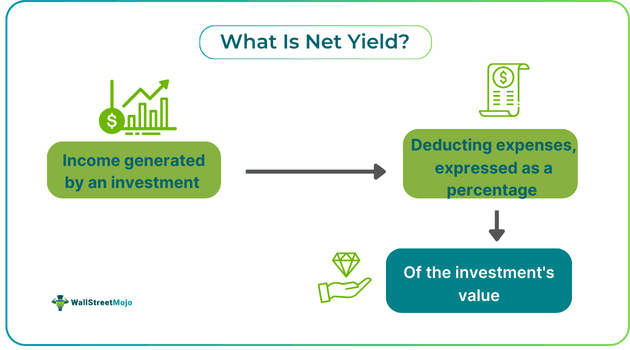Although net and gross yield are derivatives of the same product, they have a different interpretation in general. Let us look at the differences between both metrics:
Table of Contents
Net Yield Definition
Net yield is a measure that defines the returns on the investment after deducting all expenses and costs from the annual income. This metric's main purpose is to determine the investment's actual profitability, considering all costs and not just gross yield.

Usually, the investment net yield occurs on all types of assets yielding returns, such as real estate, stocks, bonds, or any financial asset. It helps in understanding the real potential income earned on an investment. It considers all costs, even taxes, before determining net returns. Thus, it acts as a factual representation of the income earned.
Key Takeaways
- Net yield is a metric used to find the net income earned after deducting all the expenses from the gross annual income.
- It applies to various assets and instruments, such as real estate, bonds, and stocks. The net rental yield is calculated in percentage form.
- This metric provides a more holistic and accurate picture of income earned than gross yield. Hence, the only difference between them is the inclusion of costs.
- However, the costs involved in each asset may differ depending on its nature
Net Yield Explained
Net yield is a take-home amount earned on an investment after subtracting expenses from the gross amount. It allows investors to estimate the actual returns gained and not get delusional about gross yield. Also, it considers the costs related to maintenance and managing the investment. For example, a person may have to pay manager's fees and taxes on mutual funds. Thus, by the year-end or asset's maturity, the investor will definitely minus these costs from the total returns received. Hence, in most cases, it is essential and accurate for investment net yield calculation as well.
Some of the costs involved in the net yield calculation depend on the type of asset owned. For instance, in rental or real estate, expenses like mortgage payments, manager's or broker's fees, insurance, repairs, maintenance, and similar others. However, in rental cases, this yield cannot be the only factor to consider. Hence, it is best suited for comprehensive and holistic analysis of the real estate owned. Other costs involved in financial assets include purchase and sale transaction costs, legal fees, stamp duty, etc.
With capital deployed in various instruments, the investors make informed decisions on where to invest. The larger yield depicts a higher recoup on the investment, which has a smaller risk and benefits capital outlay in return. Thus, it is also essential to understand that lesser capital outlay and minimal expenses can increase the required net yield basis.
Formula
Net yield is the total return received after deducting the expenses. However, there are two formulas which we can apply to calculate this yield. Let us look at them:
Net Yield = Net rental income ÷ Current Market Value
OR
Net Yield = (Gross Rent - Expenses) ÷ Current Market Value
In this context, gross rent refers to the total income generated from a property, while expenses encompass the costs of maintaining it, such as maintenance fees and taxes. The current market value indicates the property's worth based on current market conditions. For accurate calculations, it’s essential to ensure that gross rent and expenses are assessed over the same period, typically one year.
Examples
Let us look at some examples of this concept to understand how the net yield basis looks in real-time:
Example #1
Suppose Fredrick owns a property of $300,000 in his portfolio. He owned them for almost three years. But now, he wants to know the actual returns generated from his portfolio. During this one year, there were some contributions made to the assets as well. Following is the list of expenses that occurred for both:
Annual Rental Income: $24,000
Annual Expenses:
- Property taxes: $3,000
- Insurance: $1,200
- Maintenance: $2,000
- Property management fees: $1,500
Total Annual Expenses: $7,700
Initial Investment Cost: $300,000
Net yield = (Annual Income - Annual expenses) / Investment Cost
- = ($24000 - $7700) / $300,000
- = 5.4%
It is clear that a property worth $300,000 can generate a required net return rate of around five percent after deducting all expenses.
Example #2
According to a news article from October 2023, the net rental yield has increased over the past year, currently standing at 3.4% after accounting for all costs associated with maintaining a buy-to-let property. Research by Benham and Reeves analyzed the gross yields and how they change once annual running costs are considered. The findings also highlighted the impact of inflation and other macroeconomic factors on rental yields. While the net yield remains at 3.4%, it has shown improvement from 3% in the previous year, indicating greater strength and consistency in buy-to-let investing over time.
Gross Yield Vs. Net Yield
| Basis | Gross Yield | Net Yield |
|---|---|---|
| 1. Meaning | It is the total income (returns) received on an asset or financial instrument. | It refers to the net income (in the form of a percentage) earned on an asset after deducting expenses and taxes from it. |
| 2. Formula | Gross Yield = Gross income (or rent) / Market value of asset | Net yield = (Annual Income - Annual expenses) / Market value |
| 3. Factors considered | Here, no costs are included in the calculation. | It does deduct expenses and related costs from gross income. |
| 4. Accuracy | The gross yield may only provide a basic overview of the income earned. | It does provide an accurate and holistic picture of all expenses. |

